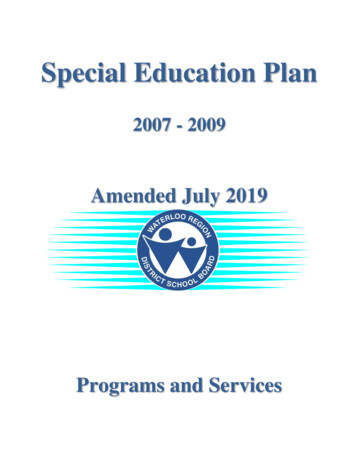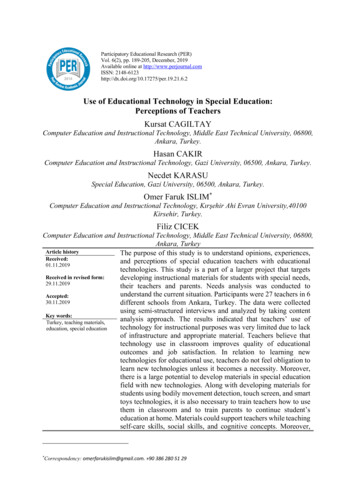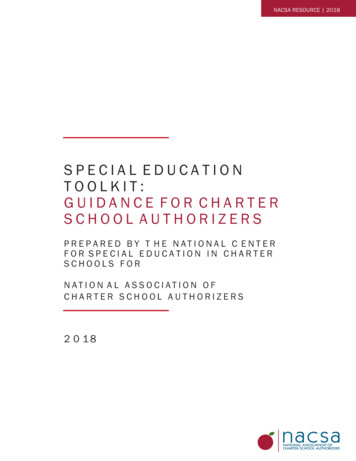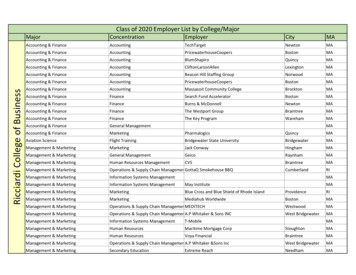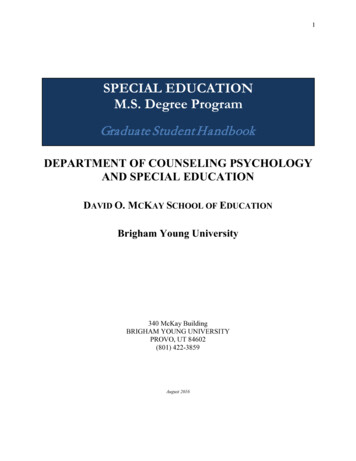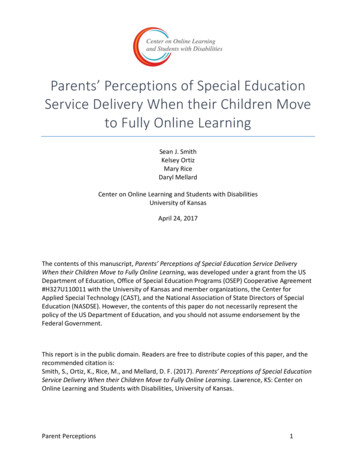
Transcription
Parents’ Perceptions of Special EducationService Delivery When their Children Moveto Fully Online LearningSean J. SmithKelsey OrtizMary RiceDaryl MellardCenter on Online Learning and Students with DisabilitiesUniversity of KansasApril 24, 2017The contents of this manuscript, Parents’ Perceptions of Special Education Service DeliveryWhen their Children Move to Fully Online Learning, was developed under a grant from the USDepartment of Education, Office of Special Education Programs (OSEP) Cooperative Agreement#H327U110011 with the University of Kansas and member organizations, the Center forApplied Special Technology (CAST), and the National Association of State Directors of SpecialEducation (NASDSE). However, the contents of this paper do not necessarily represent thepolicy of the US Department of Education, and you should not assume endorsement by theFederal Government.This report is in the public domain. Readers are free to distribute copies of this paper, and therecommended citation is:Smith, S., Ortiz, K., Rice, M., and Mellard, D. F. (2017). Parents’ Perceptions of Special EducationService Delivery When their Children Move to Fully Online Learning. Lawrence, KS: Center onOnline Learning and Students with Disabilities, University of Kansas.Parent Perceptions1
In recent years, the growth of online learning options and the availability of fully onlineeducational experiences in all 50 states has presented new opportunities for students,particularly those students with disabilities. The exponential growth in K-12 online learningopportunities has brought new expectations for stakeholders—in particular, parents,educators, and policymakers—to accommodate this new digital reality.The Individuals with Disabilities Education Act (IDEA) (2004) outlines provisions deemednecessary to ensure students with disabilities can access and benefit from public educationincluding online instructional settings. A foundational piece of IDEA is the IndividualizedEducation Program (IEP). The IEP is a highly structured legal document that is meant to clearlyarticulate which educational opportunities, placements and services are necessary for studentswith disabilities to receive a free appropriate public education (FAPE) (Fish, 2008).The main components in the IEP include, but are not limited to, (a) current levels of academicperformance, (b) annual goals that can be measured, (c) methods for measuring annual goals,(d) what special education services are needed including related services and supplementaryaides, (e) the degree to which students are with their peers in regular education, (f) appropriateaccommodations, (g) the time for which services will be carried out, and (h) testingaccommodations (Wood, 2002). Finally, an IEP team must discuss a full range of supplementalaides and related services so that students with disabilities can receive education in the leastrestrictive environment (LRE) possible (Etscheidt & Bartlett, 1999).Given the growth of online learning we wanted to learn how families of students withdisabilities described what happened with their children’s IEPs, the development andimplementation. The specific research question that we asked was the following: what doparents say happens to the IEP when they move their children to fully online schools? Thispaper describes parents’ perceptions of what happens to the special education services fortheir children when they moved to fully online schools.Review of LiteratureSince this study addresses what happens to the IEP document in the wake of school change, theliterature review covers two topics. The first is what has historically happened to servicedelivery when students change schools and residences. The second is what happens whenstudents change schools in the wake of school choice policies (particularly those school changesinvolving charter schools and homeschooling), but they do not change residences. The reviewconcludes with a conceptualization of the online environment as a movement without aresidence change.Changing Schools and Changing ResidencesBecause families have the right to take up residence in settings they see fit, student mobilitycan be attributed to either family-based or school-based reasons (Sorin & Lloste, 2006).Families may move for a number of reasons including change in parents’ employment status,lifestyle and residential changes, and shifts in family structure (Skandera & Sousa, 2002). MoreParent Perceptions2
specific reasons for movement can include job loss, moving closer to family, divorce, or birth ofa new child. Parents who move their children for school-based reasons are responding to issuesaround “social adaptability, engagement in curricula, academic difficulty, and safety” (Sorin &Lloste, 2006, p. 229). Other school-related issues for school changes include school absences,behavior problems, and low academic expectations.When Hartman and Frank (2003) conducted an in-depth review of literature designed toprovide a more comprehensive understanding of student mobility, they discovered that nonpromotional school changes are disproportionately experienced by students who tend tostruggle academically the most. Hartman and Frank identified the following studentcharacteristics associated with this phenomenon: lower socioeconomic status, minority,foreign-born, have experienced residential insecurity, were identified with a disability, were amigrant farm worker, or in the foster system.Changing Schools without Changing ResidenceStates are increasingly offering families school choice options. School choice encouragesparents to look at education options that would not have been otherwise available. Theseschool choice options can include open enrollment in magnet schools, pilot schools, voluntarymetropolitan desegregation programs, vouchers programs, charter schools, cyber charterschools, or higher performing public schools (Hastings & Weinstein, 2008). These options maycome with a promise of enriched curriculum, a better student/teacher ratio, increasedflexibility, or advanced technological applications. Parent choices for schools have created anew type of student mobility. When Rumberger and Larson (1998) examined the incidence ofmobility of students grades 8 to 12, they found that 40 percent of the students who changedschools did not change residence.Interestingly, parents of students with disabilities are among the demographic that are utilizingthe school choice option at an increasing rate. Ysseldyke, Lange, and Gorney (1994) examinedthe characteristics of students with disabilities who participated in one of Minnesota’s schoolchoice programs, Open Enrollment. This program allowed students to apply for a transferbetween school districts. In a survey in which 248 parents of children with disabilities whoapplied for transfer were asked why they wanted to move their child within the same schooldistrict, five major themes emerged from the survey and phone interviews. Those themesincluded the following: 1) the child’s needs would be better met at the new school, 2) the childwill receive more individualized attention, 3) the child is kept informed by new teachers, 4) thechild will attend school with siblings and friends, and, 5) the child is dissatisfied with formerschool. Beck, Egalite, and Maranto (2014) also conducted a survey of one online school andfound that parents of students with disabilities were more satisfied than parents of studentswithout disabilities even though satisfaction was generally high.Despite the evolution of school options and the increasing push towards personalizededucation for all children, each state must still act in accordance with IDEA to receive federalfunding for their special education programs (Turnbull et al., 2002). Criteria from which studenteligibility for special education, identification of a disability, and access to certain types ofParent Perceptions3
related and supplementary services can vary considerably from state to state. Parents may nothave the understandings they need to advocate in fully online settings and so they may havesubstantial amounts of teacher or teacher-like work without much support. For many parentsthis role was unexpected (Ortiz, Rice, Smith, & Mellard, 2017.Online Learning as a Type of Mobility without a Residential ChangeKello (2012) investigated variables that influence the choices parents made when consideringhome education or cyber-charter schooling through surveying parents that home school andparents who enrolled their children in online school. Findings from the study revealed thatparents valued flexibility, the moral climate, and positive interaction with school personnel.MethodsThis study was interested in developing phenomenological understandings about IEPdevelopment, implementation, and revision processes that occur as students move fromreceiving most of their instruction in a traditional brick-and-mortar setting to the online settingin which school work (e.g., online lessons) is completed at home under the direction of an adultwho has parental responsibilities for the child. Specifically, we wanted to know what happenedto the IEP and all its constituent parts (e.g., present levels of achievement, goals,accommodations, and services) when students with disabilities moved to online schools. Wewanted to understand from the perspective of the parent what took place as their childtransitioned into the online learning environment. Researchers collected data primarily throughphenomenological interviews (Kvale, 1983, 1994, 2009). When engaged in such work,phenomenological researchers focus on both the phenomenon and those persons who haveexperienced it (Englander, 2012).ParticipantsIn qualitative studies, participants should (1) authentically belong to the population theresearcher has determined experience the phenomenon and (2) have experience with thephenomenon (Englander, 2012; Kvale, 1994). Participants in this study were parents of childrenin grades 2 through 8 that had a disability and had enrolled in a fully online program or schoolreceiving special education services. These parents had children who were being served underIEPs in their traditional schools and whose children would have qualified for a continuation ofservices when their child moved into the fully online setting.Research staff identified parent technical assistance centers in online schools in five statesthrough state department of education websites. Some participants responded through thesecenters. To invite additional participants, principals of online schools in states with thesecenters were contacted and asked to provide information for parents that might be willing toparticipate. The goal was to contact schools that served students in at least one of the specifiedgrades 2 through 8 and offered fully online services. When a principal agreed to assist inrecruitment, a local staff member (typically a special education teacher or counselor) sentinformation to parents. Using this strategy, 11 parents and one grandparent were recruited toparticipate. The grandparent in the study was custodial and had responsibilities concomitant toParent Perceptions4
a parent, and we do not reference her differently from the other parents throughout thisdocument.Participants in the study were parents with children with a disability enrolled in a fully onlineeducational program or school and receiving special education services. Parents wereinterviewed from five states (Georgia, Utah, Ohio, Kansas, and Wisconsin). Demographicinformation about the parents and their children is contained in Table 1. All the participantswere female parents of male students. The following numbers of students were reported bytheir parents to be in the following disability categories: autism (4), emotional disturbance (1),other health impairment (4), specific learning disability (2), and speech impairment (1).The amount of time students had been enrolled in a fully online school or program ranged from6 months to more than 2 years. Three children had been enrolled for less than an entire schoolyear. Three children were working on their second full school year online. Six of the childrenhad been enrolled in a fully online environment for more than 2 years. In short, the parentsvaried in their experience with the fully online environment, but most parents had a school yearor more of experience.Table 1Participant InformationParent’sRace/EthnicityAfrican AmericanAfrican AmericanAfrican �sGenderChild’s Primary leMaleMaleMaleMaleMaleAutismOther health impairmentOther health impairmentAutismAutismAutismEmotional DisturbanceOther health impairmentOther health impairmentSpecific learning disabilitySpecific learning disabilitySpeech impairment538578344342Instrument Development and Data CollectionIndividual phone interviews with the 12 parents were recorded and transcribed. The interviewswere completed in 60 to 80 minutes. The interview protocol was developed using the currentliterature on parent involvement in online learning generally and considered COLSD research onparent involvement and engagement in online learning environments for students withdisabilities. The parents were specifically asked about the initial IEP, what happened when theonline school was informed of the IEP, whether an IEP review meeting was held, and what theParent Perceptions5
circumstances were of the meeting. In addition, parents were asked what services,accommodation, and modifications they received in the fully online environment as well as thedetails of those services and accommodations/modifications. Finally, parents indicated whetherthey perceived those services accommodations/modifications as being helpful in working withtheir children.Data AnalysisDuring data analysis, one member of the research team organized the interview data aroundwhat happened to the IEP document itself (as opposed to the content) and suggestedpreliminary categorical or nominal codes based on the current research question. A meetingwas held at which the three principal research team members evaluated and collapsed thecodes into themes and then each member checked each other’s themes. The researchersdetermined that the data for assistive technology, accommodation/modification, and otherservices was sufficiently expansive that the responses should be coded categorically. In aprocess like the first, one researcher suggested preliminary codes, and the other tworesearchers independently rated the first researcher’s codes. Then consensus was reachedamong all three researchers where disagreement occurred. This process preceded for assistivetechnology, accommodation, modification, and other services until a consensus was reachedand themes emerged that provided insight into the research questions.FindingsParticipants in this study articulated several major elements that were directly aligned to thespecial education program and the accompanying services they found during their child’stransition from the brick-and-mortar education environment to the online or fully onlinelearning experience.Perceptions of Services Leading to Identifying an Online SchoolFor the families of students with disabilities in this study, the impetus for movement to thevirtual setting was dissatisfaction with the brick-and-mortar school. Parents in this studyemphasized that they did not move to the virtual setting because of its strengths, but insteadthey were looking to exit the brick-and-mortar environment because of negative experiences.Parents expressed concern that the brick-and-mortar school was not abiding by therequirements of the IEP. Some of these complaints were about service delivery, while otherconcerns were about the kind and type of services and accommodations promised and whetherthese services would be enough to help their children be successful. One example of this typeof parental preference for a specific service came from a mother in this study that stronglybelieved her child needed to use the Diagnostic Indicators of Basic Early Literacy Skills (DIBELS)reading assessment (Good, Gruba, & Kaminiski, 2002). She was upset when the traditionalschool that her child was attending stopped using it and moved to a different type ofassessment. The mother found an online school that promised if her child enrolled, the childcould use DIBELS. The ability to say what types of services and what materials were used to givethose types of services was important to all the participating parents.Parent Perceptions6
Parents described unsuccessful advocacy in the traditional school setting to receive either basicservices or, at minimum, what their child’s IEP required. The frustration expressed by parentsindicated extensive time, energy, and even resources dedicated to ensure their child receivedappropriate services due to the needs of their child’s disability. One parent described theprocess as a metaphor for going to war:I have to admit that the school district we were in, it felt like going to war, as far as theIEP. Instead of collaborative, for the students benefit, it felt more like we had to fight forwhat we thought our son needed. CO.1., lines 100-103.Many parents were angry because they felt like they had to take on a substantial amount ofwork for serving their child or for helping school staff understand their children’s needs. Theyalso did not always approve of who provided the services and under what circumstances.We had to teach the teachers what to do. And there was always something new thatcame up with him. A lot of times he would be able to pass what they had for him in theIEP, but because he didn’t have autism as the label, there were things not listed therethat probably should have been. The teachers didn’t try. They sort of pushed it off onthe special education teacher. WI.2., lines 8-12.Parents reflected on how different the approaches were between the two settings. Central tothese differences was the process the two environments took. The brick-and-mortar settingappeared to create an adversarial environment, pitting the professionals against the parent.[The virtual IEP development] was much better, I would have to say. Our experiencetransferring from our elementary school to our middle school [both brick-and-mortar],the special education team was a very different experience. They’re understaffed at themiddle school/high school level. We felt like we were the enemy, kind of. It was a prettyhorrible experience. When [virtual school] took it [IEP] over and reviewed everything,we actually met with the Director of Special Education, who was a special educationteacher. I don’t believe the principal was involved at that initial meeting. The healthteacher was, anyone who had had any contact with him [her son] or would be. It wasvery smooth. Everyone was on the same page [virtual school IEP team]. We [virtualschool IEP team] reviewed the goals and things that we would need for the onlineenvironment. Every quarter they are assessing and reviewing his progress with hisspecific special education teacher. So, we communicate quite frequently aboutexpectations and things that he needs for assistance. WI.1., lines 45-57.Parents in this study made distinctions between the delivery of IEP services and the intendedoutcome of these services. Because the outcomes their child needed were not being realized,they pursued virtual school. In the end, the perceived limitations associated with thedevelopment and implementation of an appropriate IEP was the determining factor for theparents in this study. Parents in this study perceived that their brick-and-mortar school wasParent Perceptions7
either not calculating an IEP that was likely to help the child learn or not implementing whatthey had agreed to, which led to the search for an alternative educational setting.When we changed over [moved from a brick-and-mortar to the online school] we had tosend his IEP there [to the online school], and then I think it was within one or two weeksthat we set one up through the [online school]. We changed a lot of goals because, ofcourse, being at home is way different than in the brick-and-mortar. He succeeded sowell that first three months. He enjoyed school. WI.2., lines 57-64.Some parents reported being ignored during the transition process or relegated to followingthe various steps of the established enrollment process, not allowing personalization to thespecific needs of their son or daughter and their specific educational needs as documented inthe IEP. One parent illustrated this challenge when she attempted to share information that shehad on her child and his specific needs. During her initial conversations with the online schoolprogram she explained:I tried sending the school every report that I thought would help them to identify needs,and they accused me of sending too much. I was trying to be transparent. They didn’twant it. KS.1., lines 64-68.Overall, parents expressed a level of input dramatically different from their brick-and-mortarexperiences. Many parents contextualized their perspective on their involvement on thetransition to the online environment by first stating the challenges experienced in the previousphysical school. Their description of what worked in the movement to the online setting wasalmost always initiated with what did not work in the former school. Our interview questionsdid not specifically seek to make this comparison, yet parent after parent began with whatsituation they left, the frustration in how they were treated, and the efforts put forward toadvocate for their child.Perceptions of Orientation and its Relationship to Service DeliveryAs part of their move to an online school, parents in this study were provided orientationinformation to their role in the online setting to varying degrees. Some parents reported adramatic reframing in their own role in their children’s education.Whenever I had questions [during the initial transition] on how I’m supposed to teachhim a subject, the kindergarten teacher was available. For speech and OT [occupationaltherapy] we had gone to a community-based company. They taught me a lot about howI can do things at home. I don’t remember if it was just kindergarten or first grade, butthey gave me a lot of input about different things to try, how to calm him down, how toteach him. I don’t remember if it was kindergarten or first grade, the IEP coordinatorsaid to me, you’re not in a brick-and-mortar school, so you don’t have to do things like abrick-and-mortar school would. I think that was in first grade, and I think that’s whenthings kind of changed a little bit, how I started teaching my son. CA.1., lines 60-70.Parent Perceptions8
Others reported a more seamless orientation. Parents expressed high levels of comfort with theorientation processes when they participated and a sense that the experts were in charge andwilling to support their son or daughter in their specialized needs outlined in their IEP. Oneparent described this experience through the related services that were immediately providedupon their son’s orientation to the online classroom.[Educators at the virtual school] were very accommodating, gave him access to all thosesubjects, plus accommodations for speech. He got speech and OT online. He got anextra resource teacher. And these are people that are highly educated. One is based outof Oregon, one of his therapists. Just excellent people. They were very accommodating.He needs the same opportunities that everyone else receives. NC.1., lines 60-67.The remarks offered by parents centered on a sense of relief when the online school stepped inand made immediate promises to support their children. The level of support varied and wasoften unique to the online program. This experience is what the parents described when theysaid that the schools were so “accommodating.” Basically, the schools called them, answeredparent phone calls, and were nice. The schools also were willing to give whatever services theparents recommended. One parent had a child that she felt needed speech services, and shenarrated the lengthy process she went through in the traditional school trying to arrange thosespeech and language services. In the online school, by contrast, she told them she wantedspeech services, and she had them arranged by the end of the day. When we asked the parentsabout testing in such circumstances, they either said they could not remember the testing orthat none had taken place. This situation was also the case for determining when and ifassistive technology should be provided. The parents described the computer in and of itself asassistive technology or they did not know what we meant by “assistive technology.”Perceptions of the IEP Review ProcessWhile more parents reported some form of review of the IEP immediately, others reportedinstruction beginning right away without such a review. In these cases, the parents had little tosay other than they recently began with the lessons. Parents described a varied review processdiffering in when the review took place, the participants, and what happened as part of thereview. Parents expressed inconsistencies in what schools did as part of the IEP review,sometimes uncertainty about whether it occurred, and the process that was followed to eitherconfirm or alter the IEP for the online setting. Other parents provided a detailed account of thespecific process for the IEP review that took place within days or weeks of the initialenrollment. For example, one parent described a process in which her child’s IEP was reviewedimmediately:It [the IEP] was reviewed when he first came in. We went through an IEP meeting fromthe school that he was in saying that we were moving him. And then when we got himinto the online school after about two weeks they did an IEP for him for online schoolsbecause it’s a different environment and a lot of the things don’t correlate in an IEP inan online classroom. FL.1., lines 97-100.Parent Perceptions9
Another parent expressed a similar sentiment:I think it [IEP review by the online school] was within 30 days of moving [transferring tothe online school] up here. UT.2., lines 64-66.Typical timelines ranged from prior to the child’s admittance into the online setting toanywhere between 30 and 60 days following the child’s enrollment. No matter the details ofthe circumstances, parents were generally satisfied with the process in which the IEP wasreviewed. However, some parents did not make clear whether they fully communicated theexistence of an IEP upon enrollment in virtual school. One parent in our study was very clearthat she was not asked about an IEP and she did not volunteer that her child had one.Q: Did your child have an IEP?Parent: Yes, however, for the online program we never had them abide by it. Idon’t even know if it came up.Q: Did your child have a disability specified on the IEP when he was in the brick-andmortar?Parent: Yes.Q: What were the disabilities named?Parent: CP [Cerebral Palsy], hydrocephaly, digestive disorders. He had a walker at onepoint. CO.1., Lines 28-35.In this case, the child had fairly substantial health issues. It is noteworthy that a child could havesuch challenges and the virtual school would not notice in their interactions with neither thechild nor the parent. When we asked this mother why she enrolled her child in the virtualschool, she said that it was so she could make medical appointments easier to manage. It wassurprising that this issue, in her words, “did not come up” in conversations with virtual schoolstaff. However, this is the mother who described her interactions with the traditional schoolaround the IEP as “going to war.” Her frustration could have led her to divert conversationabout an IEP away from virtual school staff.Perceptions of Service Delivery as Part of IEP ImplementationMuch of parents’ involvement in carrying out the IEP centered on instruction. Parentsexpressed the need for them to provide support for their child in reading, lesson completion,and/or adjusting the demands of the assigned lessons. Since instructional elements are rarelydefined on the IEP, instructional information was often only footnoted in the IEPs, if at all.Parents, then often made most of the decisions about instruction and applied accommodationsand modifications as they saw fit, just as regular classroom teachers or school professionals doin traditional settings.The classes that he has taken online, if he didn’t have an IEP, I wouldn’t need to domuch of anything. But since he does have an IEP I can sit with him through them andread him everything. I know it depends on what online curriculum you’re using, but theParent Perceptions10
ones that he’s been using, if he can do it by himself then I wouldn’t need to do anythingother than to monitor that he’s on track. WI.3., lines 109-116.Accommodations were often the focus of what their child needed and what parents believedthey provide. While not necessarily listed as an accommodation on the IEP, parents reportedhaving to read to their child, identify additional resources to ensure their child comprehendedthe content, and worked with the schedule to ensure the child had the time to complete anassigned task. One parent explained her efforts in finding and then using supplementarymaterials to accommodate their child’s learning needs. Applications on the Internet were oftendescribed to us by parents when we asked about assistive technology and supplementaryservices.We use YouTube a lot. If we’re doing science, whatever the topic is I can find somethingto augment what the book is saying or to replace what the book is saying if I think it’s amore interactive type of lesson. Even for literature, if he has a story to read,
This report is in the public domain. Readers are free to distribute copies of this paper, and the recommended citation is: Smith, S., Ortiz, K., Rice, M., and Mellard, D. F. (2017). Parents' Perceptions of Special Education Service Delivery When their Children Move to Fully Online Learning. Lawrence, KS: Center on


